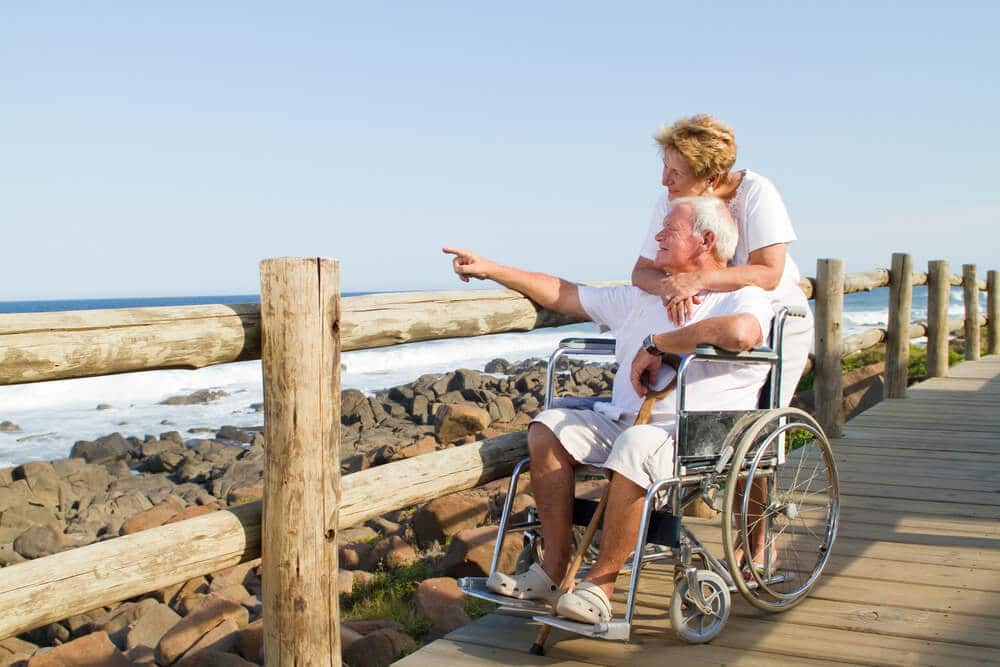Vacations for seniors with limited mobility don’t have to be a distant dream. This guide explores accessible travel destinations, adaptive equipment, and planning strategies to ensure a memorable and comfortable experience for seniors who may have mobility challenges. We’ll cover everything from finding accessible accommodations and transportation to choosing suitable activities and prioritizing health and safety. Planning ahead is key to unlocking a world of travel opportunities, regardless of physical limitations.
We’ll delve into practical advice on selecting destinations with readily available accessibility features, such as ramps, elevators, and adapted transportation. We’ll also discuss the various types of assistive devices available, helping you make informed choices about equipment rentals or purchases. Finally, we’ll provide budgeting tips and address common concerns to empower you to confidently plan and enjoy an accessible vacation.
Accessible Travel Destinations
Planning a vacation with limited mobility requires careful consideration of accessibility features. Choosing the right destination can significantly enhance your travel experience, ensuring comfort and enjoyment. This section details ten destinations known for their accessibility, along with specific examples of accessible features at airports, hotels, and popular attractions.
Accessible Travel Destinations: A Detailed Overview
The following table lists ten destinations suitable for seniors with limited mobility, highlighting key accessibility features. Consideration has been given to climate, terrain, and ease of navigation.
| Destination | Airport Accessibility | Hotel Accessibility | Attraction Accessibility |
|---|---|---|---|
| San Diego, California, USA | San Diego International Airport (SAN) offers wheelchair assistance, accessible restrooms, and elevators. | Numerous hotels offer accessible rooms with roll-in showers, wider doorways, and grab bars. Examples include the Hotel del Coronado and Paradise Point Resort & Spa. | Balboa Park offers paved pathways, accessible restrooms, and ramps at many attractions. The San Diego Zoo offers wheelchair rentals and accessible trams. |
| Charleston, South Carolina, USA | Charleston International Airport (CHS) provides wheelchair assistance and accessible facilities. | Many historic hotels in Charleston have undergone renovations to include accessible rooms. Look for hotels that explicitly mention accessibility features on their websites. | While some older areas may present challenges, many historic sites offer accessible entrances and ramps. Consider using a wheelchair taxi for longer distances. |
| Amsterdam, Netherlands | Amsterdam Airport Schiphol (AMS) is renowned for its excellent accessibility, with clear signage, elevators, and wheelchair assistance readily available. | Many hotels in Amsterdam cater to guests with disabilities, offering accessible rooms and facilities. | Amsterdam is relatively flat and features well-maintained pathways and canals. Many museums and attractions provide wheelchair access and ramps. |
| Quebec City, Canada | Jean Lesage International Airport (YQB) provides standard airport accessibility services. | Several hotels in Quebec City offer accessible rooms. It’s advisable to book in advance and confirm accessibility features directly with the hotel. | While some areas of Old Quebec involve cobblestones, many attractions offer accessible entrances and elevators. Consider using accessible taxis or guided tours. |
| Bath, England | London Heathrow Airport (LHR) is the closest major airport, offering comprehensive accessibility services. Ground transportation to Bath is readily available. | Many hotels in Bath offer accessible rooms. Check hotel websites or contact them directly to confirm. | Bath’s Roman Baths offer wheelchair access and ramps. Many other attractions in the city also provide accessible routes. |
| Honolulu, Hawaii, USA | Honolulu International Airport (HNL) offers standard airport accessibility services. | Many hotels in Waikiki and other areas offer accessible rooms. Look for hotels that explicitly mention accessibility features. | Many attractions, including beaches (with accessible pathways in some areas), offer varying degrees of accessibility. |
| San Antonio, Texas, USA | San Antonio International Airport (SAT) provides standard airport accessibility services. | Numerous hotels in San Antonio offer accessible rooms. Check hotel websites for details. | The River Walk has accessible pathways in many sections. The Alamo and other historical sites offer varying degrees of accessibility. |
| Vienna, Austria | Vienna International Airport (VIE) offers standard airport accessibility services. | Many hotels in Vienna offer accessible rooms. Check hotel websites or contact them directly to confirm. | Vienna’s city center is relatively flat and walkable, with many attractions offering accessible entrances. |
| Seville, Spain | Seville Airport (SVQ) offers standard airport accessibility services. | Many hotels in Seville offer accessible rooms. It’s best to confirm accessibility features directly with the hotel. | Seville’s historic center has some cobblestone streets, but many attractions offer accessible entrances and ramps. |
| Kyoto, Japan | Kansai International Airport (KIX) offers excellent accessibility services. | Many hotels in Kyoto offer accessible rooms. It’s advisable to book in advance and confirm accessibility features. | While some traditional areas may present challenges, many temples and gardens offer accessible pathways and ramps. |
Sample One-Week Itinerary: San Diego, California
This itinerary focuses on San Diego, California, highlighting accessible transportation options and attractions.
Day 1: Arrival at San Diego International Airport (SAN). Utilize wheelchair assistance if needed. Transfer to an accessible hotel via taxi or pre-booked accessible shuttle. Afternoon: Relax and acclimatize.
Day 2: Explore Balboa Park. Utilize accessible pathways and trams where available. Visit the San Diego Zoo, taking advantage of wheelchair rentals and accessible trams.
Day 3: Visit the USS Midway Museum. The museum offers accessible ramps and elevators. Afternoon: Relax on the beach at Coronado Island (accessible pathways available in some areas).
Day 4: Explore Old Town San Diego State Historic Park. While some areas may have uneven surfaces, accessible pathways exist in many sections. Utilize accessible taxis or ride-sharing services for longer distances.
Day 5: Visit the Gaslamp Quarter. Many areas are accessible, though some older buildings may present challenges. Utilize accessible taxis or ride-sharing services as needed.
Day 6: Enjoy a relaxing day. Explore the hotel amenities or take a scenic drive along the coast (consider accessible transportation options).
Day 7: Departure from San Diego International Airport (SAN). Utilize wheelchair assistance if needed.
Adaptive Travel Equipment and Services
Planning a trip when you have limited mobility requires careful consideration of the equipment and services that can make your journey comfortable and enjoyable. Choosing the right adaptive travel equipment can significantly impact your overall travel experience, allowing you to participate more fully in activities and explore destinations with greater ease and independence. This section will explore various options and factors to consider when selecting and utilizing adaptive travel equipment.
Assistive Devices for Enhanced Travel Experiences
Selecting appropriate assistive devices is crucial for seniors with limited mobility. The right equipment can transform a potentially challenging trip into a memorable and accessible adventure. The following examples highlight some common options:
- Wheelchairs: Manual wheelchairs offer a degree of independence, while powered wheelchairs provide greater ease of movement, especially over longer distances or uneven terrain. Consider the weight capacity, maneuverability, and foldability for ease of transport.
- Walkers: Walkers provide stability and support for those who can ambulate but require assistance. Features like adjustable height and seat options can enhance comfort and usability. Consider the weight and ease of folding for transport.
- Mobility Scooters: Mobility scooters offer a balance between independence and ease of use. They are generally more compact and maneuverable than wheelchairs, but their range and weight capacity may vary. Think about the battery life, terrain capabilities, and ease of storage during travel.
- Rollators: Rollators combine the features of a walker and a mobility scooter, offering support and mobility. They typically have brakes, a seat, and a basket for carrying belongings.
Benefits and Drawbacks of Adaptive Equipment
Each type of adaptive equipment presents unique benefits and drawbacks. Careful consideration of these factors is essential for making an informed decision.
- Wheelchairs: Benefits include excellent support and maneuverability in various environments. Drawbacks can include weight, size, and potential difficulties navigating uneven terrain or crowded spaces.
- Walkers: Benefits include increased stability and support for walking. Drawbacks may include limited range and slower speed compared to other options.
- Mobility Scooters: Benefits include ease of use, greater speed and range than walkers, and enhanced independence. Drawbacks include size and weight, potential limitations on navigating very uneven terrain, and battery life concerns.
- Rollators: Benefits include the combination of support and mobility. Drawbacks include limitations on navigating extremely uneven terrain or very crowded spaces.
Renting or Purchasing Adaptive Travel Equipment
The decision to rent or purchase adaptive travel equipment depends on several factors, including the duration of the trip, the cost of equipment, and the availability of rental services at the destination.
When considering rental, investigate local companies specializing in mobility equipment rentals. Confirm the availability of the desired equipment, its condition, and the rental terms. Consider the size and weight of the equipment to ensure compatibility with your transportation arrangements. For example, ensure that your chosen wheelchair or scooter will fit comfortably in an airplane’s overhead compartment or a rental car’s trunk. Compatibility with various modes of transportation is paramount.
When purchasing, consider the long-term use of the equipment. Factor in the cost, durability, and maintenance requirements. Choose equipment that meets your specific needs and physical limitations, and again, ensure compatibility with various transportation modes. Consider factors like weight, foldability, and ease of transport when making your decision.
Activities and Experiences for Seniors with Limited Mobility
Planning vacations for seniors with limited mobility requires careful consideration of activities that are both enjoyable and accessible. The key is to find a balance between engaging experiences and maintaining comfort and safety. This involves selecting activities appropriate to individual fitness levels and ensuring suitable accessibility features are available.
Suitable Activities Categorized by Physical Exertion
Choosing activities based on physical exertion levels is crucial for a positive travel experience. The following table categorizes suitable activities, considering accessibility and exertion.
| Activity | Location | Accessibility Level | Description |
|---|---|---|---|
| Botanical Garden Visit | Many major cities and towns | Low | Most botanical gardens offer paved pathways, benches for rest, and accessible restrooms. Enjoy the beauty of nature at a relaxed pace. |
| Museum Tour | Major cities worldwide | Low to Moderate | Many museums offer wheelchair rentals, elevators, and accessible entrances. Choose museums with well-maintained pathways and ample seating. |
| Scenic Train Ride | Various locations offering scenic routes | Low | Enjoy breathtaking views from the comfort of a seated train car. Many scenic train routes offer accessible carriages. |
| Guided City Tour (Bus or Wheelchair Accessible Van) | Most major cities | Low to Moderate | Pre-booked tours often provide accessible transportation and knowledgeable guides who can adjust the pace to suit the group’s needs. |
| Whale Watching (from a stable boat) | Coastal regions | Low to Moderate | Choose a tour operator that guarantees accessible boarding and stable vessel. Enjoy the incredible spectacle of whales from a comfortable position. |
| Art Gallery Visit | Major cities and towns | Low | Most modern art galleries are designed with accessibility in mind, offering ramps, elevators, and ample space for wheelchairs. |
| Relaxing Spa Day | Hotels and resorts | Low | Indulge in therapeutic treatments in a relaxing and accessible environment. Many spas offer accessible facilities and treatments tailored to individual needs. |
| Easy Walking Tour (with frequent rest stops) | Historic districts, parks | Moderate | Choose shorter routes with plenty of benches and rest areas. Focus on key landmarks and attractions, prioritizing comfort and pacing. |
Adapting Popular Activities for Different Mobility Levels
Many popular activities can be adapted to accommodate varying levels of mobility. For example, hiking trails can be modified by choosing shorter, less strenuous routes or utilizing accessible transportation to reach scenic overlooks. Sightseeing can be adapted by using alternative viewing options, such as accessible bus tours, boat trips, or even virtual reality experiences for locations with limited accessibility. Consider using mobility aids like wheelchairs, walkers, or canes as needed. For example, instead of a strenuous hike, a scenic gondola ride could provide similar breathtaking views with minimal physical exertion.
Importance of Pacing and Rest During Travel
Pacing and rest are paramount for seniors with limited mobility. It’s essential to build in ample time for rest throughout the day, avoiding overexertion. Plan for frequent breaks, and allow extra time for transfers and navigation. Prioritize comfort and avoid rushing. For example, schedule shorter activity periods followed by longer rest periods. This approach ensures a more enjoyable and less stressful travel experience, preventing fatigue and potential health issues.
Health and Safety Considerations
Planning a vacation, especially for seniors with limited mobility, requires careful consideration of health and safety. Proactive measures can significantly enhance the enjoyment and reduce potential risks associated with travel. This section details essential precautions to ensure a smooth and worry-free trip.
Prioritizing health and safety during travel involves meticulous preparation and ongoing vigilance. Effective communication with healthcare providers and airport personnel is crucial, alongside packing essential medical supplies and comfort items. Appropriate travel insurance is also paramount.
Necessary Medications, Emergency Contacts, and Travel Insurance
Maintaining a consistent medication regimen is vital. Pack sufficient medication for the entire trip, plus a few extra days’ supply in case of delays. Carry prescriptions in their original containers and consider carrying a copy of your prescription in case of loss or damage. Establish clear emergency contacts, including family, friends, and your physician. Provide these contacts with your itinerary and keep them updated on your whereabouts. Comprehensive travel insurance is strongly recommended to cover medical emergencies, trip cancellations, and lost luggage. This insurance should specifically address the needs of individuals with limited mobility, potentially covering specialized medical evacuation or equipment replacement. Consider researching policies that cover pre-existing conditions.
Communicating Mobility Needs with Healthcare Providers and Airport Staff
Open and clear communication is essential. Before departure, inform your physician about your travel plans and any potential health concerns. Discuss any necessary adjustments to your medication schedule or potential health risks associated with travel. Provide your physician with your itinerary so they can offer appropriate advice. At the airport, notify airline staff about your mobility needs well in advance of your flight. Request assistance with check-in, baggage handling, and boarding. Clearly communicate any specific requirements, such as wheelchair assistance, aisle seats, or accessible restroom access. The airport staff is generally well-equipped to handle these requests, but early notification ensures smoother processing.
Essential Items to Pack for an Accessible Vacation
Packing appropriately for an accessible vacation requires careful planning. The following list highlights essential items to ensure comfort, safety, and independence throughout your trip:
- Medications: Sufficient prescription and over-the-counter medications, including pain relievers, allergy medications, and any other regularly used medications. Keep a list of medications and dosages readily available.
- Medical Supplies: First-aid kit including bandages, antiseptic wipes, pain relievers, any personal medical devices (e.g., inhaler, blood sugar monitor with extra supplies), and any mobility aids such as crutches or a cane (if needed).
- Comfort Items: Comfortable clothing and shoes, lightweight blanket or shawl, travel pillow, and any personal comfort items that will aid relaxation and reduce stress.
- Adaptive Equipment: If using a wheelchair or other mobility aids, ensure they are appropriately packed and readily accessible. Carry any necessary repair tools or replacement parts. Consider bringing a lightweight, portable ramp if needed for navigating steps or uneven surfaces.
- Identification and Documents: Photo ID, passport, travel insurance information, emergency contact information, and copies of prescriptions.
- Communication Devices: Fully charged cell phone, international calling card (if necessary), and a portable charger.
Budgeting for Accessible Travel
Planning a vacation, especially one that caters to specific accessibility needs, requires careful budgeting. Failing to account for all potential costs can lead to unexpected financial strain and detract from the enjoyment of the trip. A well-structured budget ensures a relaxing and worry-free experience.
Creating a realistic budget involves meticulously estimating expenses across several key areas. This includes transportation costs (flights, airport transfers, ground transportation), accommodation fees (considering accessibility features and potential extra charges), activity costs (entrance fees, guided tours, adapted experiences), and the cost of any necessary adaptive equipment (wheelchairs, mobility aids, etc.). Remember to factor in potential unexpected costs, building a buffer into your budget for unforeseen circumstances.
Transportation Costs
Transportation forms a significant part of any travel budget. Air travel often involves additional fees for checked baggage (especially for larger mobility equipment) and assistance services. Consider booking flights well in advance to secure better fares and potentially negotiate better rates for assistance. Ground transportation should also be carefully planned, comparing costs and accessibility features of taxis, ride-sharing services, and public transportation. For example, a round-trip flight for two people to a popular accessible destination like Orlando, Florida, could cost between $1,000 and $2,500, depending on the time of year and origin. Airport transfers and local transportation could add another $300-$500.
Accommodation Costs
Accessible accommodations often come at a premium. Hotels and resorts offering accessible rooms may charge higher rates than standard rooms. Explore options such as vacation rentals, which can sometimes offer more space and adaptable features at a potentially lower cost. Consider comparing prices across several platforms and reading reviews to ensure the advertised accessibility features are accurately represented. For instance, a week-long stay in an accessible hotel room in a popular tourist destination could range from $1,000 to $3,000, depending on the location and the hotel’s rating. Vacation rentals could potentially offer similar accommodations at a slightly lower cost, averaging between $800 and $2,500 for a week.
Activity Costs
Activities are crucial for a fulfilling vacation. Research accessible attractions and tours beforehand. Many destinations offer adapted experiences, but these may come with additional fees. Consider the cost of entrance tickets, guided tours, and any specialized equipment rentals needed for participation. For example, a tour of a historical site with wheelchair access might cost $50-$100 per person, while specialized adapted tours could cost more. Pre-booking can sometimes secure discounts.
Adaptive Equipment Costs
The cost of adaptive equipment can vary widely. If you require specialized equipment, factor in rental or purchase costs. Check if your insurance covers any of these expenses. Explore rental options for equipment you may only need during your trip, as this could be more cost-effective than purchasing new equipment. For example, renting a lightweight wheelchair for a week might cost between $100 and $200, while purchasing a new one could range from $500 to $2,000 or more depending on features.
Cost Comparison of Different Travel Options
All-inclusive resorts often offer convenience but may be more expensive than independent travel. Cruises can be appealing but require careful consideration of accessibility features and potential additional charges. Independent travel allows for greater flexibility and potential cost savings through careful planning and utilizing budget-friendly options. A detailed comparison of these options would require specific examples and destination data, but generally, independent travel can be more budget-friendly if planned carefully, while all-inclusive resorts provide convenience at a higher price point. Cruises vary widely in cost, with accessible cabins commanding higher prices.
Saving Money on Accessible Travel
Senior discounts are often available for transportation, accommodation, and attractions. Consider traveling during the off-season or shoulder season to benefit from lower prices. Explore budget-friendly destinations that offer accessible options without compromising on quality. Look for package deals that combine transportation and accommodation to potentially reduce overall costs. Websites and travel agencies specializing in accessible travel can often provide valuable insights and deals.
Epilogue
Ultimately, planning a fulfilling vacation for seniors with limited mobility involves careful consideration of several factors, but the rewards are immeasurable. By utilizing the resources and strategies outlined in this guide, you can overcome potential challenges and create a travel experience that is both enjoyable and enriching. Remember, accessible travel is about embracing adventure while prioritizing comfort and safety. With proper planning, the world awaits!




